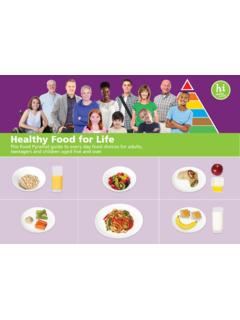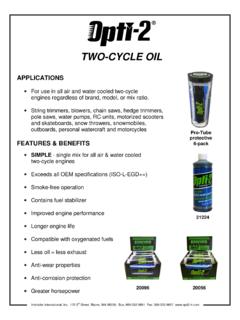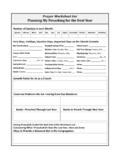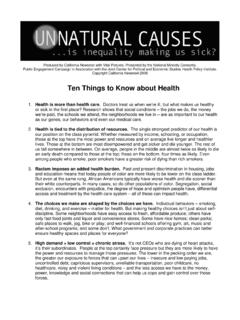Transcription of GCSE Exam Questions on Volume - Bemrose
1 gcse Exam Questions on Volume question 1. (AQA June 2003 Intermediate Paper 2 Calculator OK) A large carton contains 4 litres of orange juice. Cylindrical glasses of height 10 cm and radius 3 cm are to be filled from the carton. How many glasses can be filled? You must show all your working. [5 marks] question 2. (AQA June 2006 Intermediate Paper 2 Calculator OK) The diagram shows two boxes that are cuboids. The larger box measures 20cm by 10cm by 20cm. It is partly filled with 70 smaller boxes each measuring 5cm by 5cm by 2cm. The smaller boxes are packed so that there are no gaps between them. How many more smaller boxes could be fitted into the larger box? [4 marks] question 3. (AQA November 2004 Intermediate Paper 2 Calculator OK) A cylinder has a radius of 5 cm. (a) Calculate the circumference of a circular end of the cylinder. [2 marks] (b) The cylinder has a Volume of 250 cm3. Calculate the height of the cylinder.
2 [3 marks] gcse Exam Questions on Volume question 4. (AQA November 2006 Intermediate Paper 2 Calculator OK) A water container is in the shape of a cuboid. Its base is 20cm by 20cm and the depth of the water in the container is 15cm. Tony adds 1000 cm3 of water to the container. Calculate the new depth, d, of the water, in centimetres. [4 marks] question 5. (AQA June 2003 Intermediate Paper 1 NO Calculator) A school hall is in the shape of a cuboid. The school hall is 30 m long, 12 m wide and 4 m tall, as shown in the diagram. (a) Calculate the Volume of the hall. [2 marks] (b) Calculate the total area of the four walls of the hall. [3 marks] gcse Exam Questions on Volume question 6. (AQA November 2007 Intermediate Paper 2 Calculator OK) A bag filled with sand is a cube along each side, as shown in the diagram. The bag holds 1 tonne of sand. Find the density of the sand. Give your answer in kilograms per cubic metre.
3 [3 marks] question 7. (AQA June 2005 Intermediate Paper 1 NO Calculator) The diagram shows a cylinder. The diameter of the cylinder is 10 cm. The height of the cylinder is 10 cm. (a) Calculate the Volume of the cylinder. Give your answer in terms of . [3 marks] Twenty of the cylinders are packed in a box of height 10cm. The diagram shows how the cylinders are arranged inside the box. The shaded area is the space between the cylinders. (b) Work out the Volume inside the box that is not filled by the cylinders. Give your answer in terms of . [4 marks] gcse Exam Questions on Volume question 8. (AQA June 2007 Intermediate Paper 1 NO Calculator) The diagram, shows a container in the shape of a cuboid. (a) Work out the Volume of the container. State the units of your answer. [3 marks] (b) Ben wants to paint the four outside walls and the top of the container. One tin of paint covers 6 m2. How many tins of paint does Ben need?
4 You must show all your working. [4 marks] question 9. (AQA November 2007 Intermediate Paper 1 NO Calculator) The diagram shows a cylinder. The diameter of the cylinder is 20 cm. The height of the cylinder is 2 cm. Work out the Volume of the cylinder. Use = [3 marks] gcse Exam Questions on Volume question 10. (AQA November 2003 Intermediate Paper 1 NO Calculator) The diagram shows a silver bar. The cross-section of the silver bar is a trapezium. (a) Calculate the area of the cross-section. [2 marks] The silver bar is 15 cm long. The bar is melted and the silver is then made into a cuboid. The base of the cuboid is 10cm by 10cm. (b) Work out the height of the cuboid. [3 marks] question 11. (AQA June 2003 Higher Paper 2 Calculator OK) A thin-walled glass paperweight consists of a hollow cylinder with a hollow cone on top as shown. The paperweight contains just enough sand to fill the cylinder.
5 The paperweight is now turned upside down. Calculate the depth of the sand (marked x in the diagram). [5 marks] gcse Exam Questions on Volume question 12. (AQA November 2007 Intermediate Paper 1 NO Calculator) One face of a cuboid is drawn on this isometric grid. This face measures 3cm by 4cm. (a) The Volume of the cuboid is 24 cm3. Complete the drawing of the cuboid. [3 marks] (b) Work out the surface area of the cuboid below. State the units of your answer. [3 marks] question 13. (AQA June 2004 Higher Paper 2 Calculator OK) A water tank is 50cm long, 34cm wide and 24cm high. It contains water to a depth of 18 cm. Four identical spheres are placed in the tank and are fully submerged. The water level rises by cm. Calculate the radius of the spheres. [5 marks] gcse Exam Questions on Volume question 14. (AQA June 2005 Higher Paper 2 Calculator OK) A marble paperweight consists of a cuboid and a hemisphere as shown in the diagram.
6 The hemisphere has a radius of 4 cm. Calculate the Volume of the paperweight. [4 marks] question 15. (AQA November 2003 Higher Paper 2 Calculator OK) A square-based pyramid has a base of edge 5 cm. The vertex of the pyramid is directly over the midpoint of the base. The Volume of the pyramid is 100 cm3. Find the length of the slant edge of the pyramid (marked x in the diagram). [5 marks] gcse Exam Questions on Volume question 16. (AQA June 2007 Higher Paper 2 Calculator OK) Two spheres of radius 5 cm just fit inside a tube. Calculate the Volume inside the tube not filled by the spheres. [5 marks] question 17. (AQA November 2003 Higher Paper 2 Calculator OK) A solid cube has a square hole cut through horizontally and a circular hole cut through vertically. Both holes are cut centrally in the appropriate faces. The dimensions of the cube and the hole are shown in the diagram. Calculate the Volume remaining after the holes have been cut.
7 [5 marks] question 18. (AQA November 2004 Higher Paper 2 Calculator OK) A cylinder has a radius of 5 cm and a Volume of 250 cm3. Calculate the height of the cylinder. [3 marks] gcse Exam Questions on Volume question 19. (AQA November 2006 Higher Paper 2 Calculator OK) ABCD is a triangular based pyramid. The base ABC is an equilateral triangle with sides 5 cm. The Volume of the pyramid is 36 cm3. Calculate the perpendicular height, h, of the pyramid. [4 marks] question 20 AQA November 2007 Higher Paper 2 Calculator OK) A solid sphere of radius 3 cm just fits inside a hollow cone of radius 6cm and height 8cm. A (vertical) cross-sectional view is shown in the diagram. Calculate the fraction of the Volume of the cone taken up by the sphere. You must show your working. [3marks] gcse Exam Questions on Volume question 21 (AQA November 2003 Higher Paper 1 NO Calculator) The first diagram shows a cone of base radius 12 cm and perpendicular height 10 cm.
8 A small cone of base radius 6 cm and perpendicular height 5 cm is cut off the bottom to leave a frustum. The frustum has a lower radius of 6 cm, an upper radius of 12 cm and a perpendicular height of 5 cm (see second diagram). (a) Find the Volume of the frustum, giving your answer in terms of . [4 marks] (b) The frustum has the same Volume as another cone of perpendicular height 35 cm. Calculate the radius of this cone. [3 marks] gcse Exam Questions on Volume question 22. (AQA November 2005 Higher Paper 1 NO Calculator) A hemispherical bowl of radius 6 cm has the same Volume as a cone of perpendicular height 27 cm. Calculate the base radius, r, of the cone. [4 marks]






